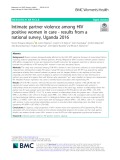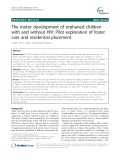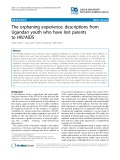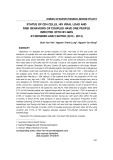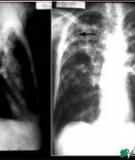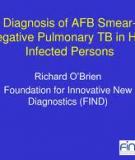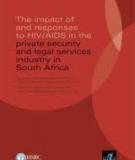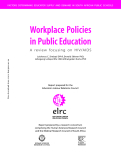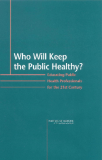
AIDS epidemic
-
Part 1 book "Mathematical models in epidemiology" includes content: A prelude to mathematical epidemiology, simple compartmental models for disease transmission, endemic disease models, epidemic models, models with heterogeneous mixing, models for diseases transmitted by vectors, models for tuberculosis, models for HIV/AIDS.
 322p
322p  oursky07
oursky07
 24-10-2023
24-10-2023
 3
3
 2
2
 Download
Download
-
Women remain disproportionally affected by the HIV/ AIDS epidemic because of sociocultural factors including violence perpetrated by intimate partners. Among HIVpositive (HIV+) women, intimate partner violence (IPV) affects engagement in care and reproductive health outcomes.
 10p
10p  vitokyo2711
vitokyo2711
 31-08-2020
31-08-2020
 8
8
 2
2
 Download
Download
-
The AIDS epidemic has lead to an increase in orphaned children who need residential care. It is known that HIV leads to delayed motor development. However, the impact of place of residence on motor function has not been investigated in the South African context.
 7p
7p  virubber2711
virubber2711
 21-03-2020
21-03-2020
 16
16
 2
2
 Download
Download
-
Pulmonary system is the most commonly involved system in people living with HIV as lungs are continuously exposed to the infection as they are rich in macrophages, dendritic cells, lymphocytes etc. In PLHIV immunity is suppressed, hence lungs are prone for infection and non infectious pulmonary diseases. According to autopsy findings, in HIV lung was affected almost upto 100% in the period of epidemic to 70% in the HAART era. Pneumonia is most common pulmonary manifestation followed by pulmonary tuberculosis and PCP.
 4p
4p  trinhthamhodang3
trinhthamhodang3
 12-02-2020
12-02-2020
 19
19
 0
0
 Download
Download
-
The HIV/AIDS epidemic has continued to pose significant challenges to countries in Sub-Saharan Africa. Millions of African children and youth have lost parents to HIV/AIDS leaving a generation of orphans to be cared for within extended family systems and communities.
 10p
10p  viamsterdam2711
viamsterdam2711
 07-01-2020
07-01-2020
 9
9
 1
1
 Download
Download
-
AIDS is still an incurable disease and is very costly to control. Since the first case of Acquired Immune Deficiency Syndrome (AIDS) in Nigeria was reported in 1986, the human immune deficiency virus (HIV) infection has attained epidemic proportion. In an attempt to control this rapid spread, certain preventive measures have been developed. In spite of these and the campaigns to control it, the gap between the knowledge and attitudes of youths towards HIV/AIDS needs to be bridged.
 9p
9p  quenchua2
quenchua2
 15-12-2019
15-12-2019
 11
11
 2
2
 Download
Download
-
To describe the current situation of CD4, viral load of HIV and some risk behaviors of couples with one new detected infected HIV person was managed at outpatient clinic at Dienbien and Cantho provinces (2013 - 2014).
 9p
9p  viwashington2711
viwashington2711
 03-12-2019
03-12-2019
 12
12
 1
1
 Download
Download
-
According to the 2009 Indonesia Country Report on the follow-up to the Declaration of Commitment on HIV/AIDS, the HIV epidemic in Indonesia is among the fastest growing in Asia. HIV infection rates are the highest in Papua (2.4%), where it has spread to the general population. With large mining, migrant worker and fishing industries, Papua is a likely source for increased HIV transmission throughout the region.
 24p
24p  seketnoi
seketnoi
 28-04-2013
28-04-2013
 35
35
 3
3
 Download
Download
-
This research monograph compares mechanisms for the financing of HIV/AIDS programmes in these six sub-Saharan countries. It aims to assess their ability and readiness to respond to the HIV/AIDS epidemic. The report presents a brief synopsis of the economic context of each country and determines whether health and HIV/AIDS expenditure is adequate.
 0p
0p  chieckhanpieu
chieckhanpieu
 19-03-2013
19-03-2013
 40
40
 1
1
 Download
Download
-
The World Bank and the Center for International Comparisons at the University of Pennsylvania, USA. As the trend from 1990 to 2010 is estimated, the time reference of the data gathered starts from 1985, in order to cover fully the period around 1990. Deaths due to AIDS were obtained from UNAIDS (unpublished tables from the Global Report: UNAIDS Report on the Global AIDS Epidemic 2010.
 37p
37p  nhamnhiqa
nhamnhiqa
 01-03-2013
01-03-2013
 43
43
 1
1
 Download
Download
-
Responding to the disease burden of Communicable and Noncommunicable Diseases (NCD), the WCO will help strengthen the national capacity to reduce morbidity and mortality due to AIDS, tuberculosis and malaria, achieve high-level immunization coverage with all antigens in order to reduce the burden of vaccine-preventable diseases, achieve the eradication of polio, elimination/control of measles and neonatal tetanus, reduce morbidity due to helminthiasis, eliminate leprosy, intensify surveillance and response to epidemic-prone diseases, and reduce/control the burden of NCDs, while paying atten...
 70p
70p  nhamnhiqa
nhamnhiqa
 01-03-2013
01-03-2013
 57
57
 1
1
 Download
Download
-
Rapidly expand access to diversified HIV testing and counselling services. HIV testing must be voluntary, confidential and accompanied by appropriate counselling, whether initiated by the client or the provider. Accelerated uptake of rights-based testing and counselling services for adults and children is required for prevention and early diagnosis and referral (as required) to care and treatment programmes and to support safe disclosure of HIV status.
 229p
229p  nhamnhiqa
nhamnhiqa
 01-03-2013
01-03-2013
 35
35
 2
2
 Download
Download
-
the need for coordinated health sector action on hiv. Evidence and experience to date provide a compelling rationale for a new global health sector strategy on HIV. The WHO strategy is designed to meet the complex challenges of a dynamic epidemic in a rapidly evolving stage of global health actors. WHO’s work on HIV has been guided by a series of broad-based strategies and initiatives, including the Global health-sector strategy on HIV/AIDS 2003–2007, the “3 by 5” initiative, and the WHO 2006-2010 plan for universal access.
 34p
34p  nhamnhiqa
nhamnhiqa
 01-03-2013
01-03-2013
 64
64
 1
1
 Download
Download
-
We live in an era in which public health is debated all around us, every day. Big questions emerge constantly: What’s the best way to deliver health care or respond to natural disaster? How will climate change affect health? What can we do to ensure clean, safe water for a planet of seven billion? Some of the puzzles that we in public health try to solve are fairly recent, such as the obesity and diabetes epidemics. Other quandaries have been around longer. The HIV/AIDS epidemic is three decades old now. Cigarettes have been identified as killers for more than half a century.
 237p
237p  nhamnhiqa
nhamnhiqa
 01-03-2013
01-03-2013
 43
43
 2
2
 Download
Download
-
The relationship between tuberculosis and mankind has been known for many centuries, with the disease being one of the major causes of illness and death. During the early 1980s, therewas a widespread belief that the diseasewas being controlled, but by the mid-1980s, the number of cases increased. This change in the epidemiological picture has several causes, of which the AIDS epidemic, the progression of poverty in developing countries, the increase in the number of elderly people with an altered immune status and the emergence of multidrug-resistant tuberculosis are the most important.
 15p
15p  taisaocothedung
taisaocothedung
 12-01-2013
12-01-2013
 55
55
 1
1
 Download
Download
-
The HIV epidemic has led to large increases in the frequency of smear-negative pulmonary tuberculosis, which has poor treatment outcomes and excessive early mortality compared with smear-positive disease. We used a combination of systematic review, document analysis, and global expert opinion to review the extent of this problem.
 8p
8p  taisaocothedung
taisaocothedung
 12-01-2013
12-01-2013
 49
49
 1
1
 Download
Download
-
The generalised nature of the HIV/AIDS epidemic in South Africa means that it impacts unevenly on businesses. Companies respond in varied ways, and with varied means, to the challenges posed by the epidemic. Assessment of the impacts of HIV/AIDS, and of the responses of companies to it, are critical to help mitigate the impact of the epidemic on productivity, labour costs, and the supply of skills.
 0p
0p  quatet
quatet
 12-01-2013
12-01-2013
 61
61
 2
2
 Download
Download
-
Policy governs many aspects of the professional lives of educators. It is also central to their and the sector’s response to crises such as the HIV/AIDS epidemic. As such policy can contribute directly to curtailing the attrition of educators, by encouraging and providing protection against threats such as HIV/AIDS, and by creating a positive and supportive working environment. This study examines workplace and HIV/AIDS policies from the Department of Education (DoE) and the HIV/AIDS policies of two trade unions, as part of a broader study looking at the attrition of educators.
 0p
0p  quatet
quatet
 12-01-2013
12-01-2013
 42
42
 2
2
 Download
Download
-
Women’s property and inheritance rights are recognised in international law and in a growing number of countries worldwide, yet women in many developing countries do not have the right to own or inherit property. At the same time, women are increasingly heading up households and are in critical need of land and property for economic security, particularly in the context of the AIDS epidemic - in fact, secure property rights are believed to be a factor in reducing women’s risk of contracting HIV and in protecting them from domestic violence....
 0p
0p  quatet
quatet
 08-01-2013
08-01-2013
 63
63
 2
2
 Download
Download
-
a world where health threats range from AIDS and bioterrorism to an epidemic of obesity, the need for an effective public health system is as urgent as it has ever been. An effective public health system requires well-educated public health professionals. Public health professionals receive education and training in a wide range of disciplines, come from a variety of professions, work in many types of settings, and are engaged in numerous kinds of activities; however, all public health professionals share a focus on population-level health.
 321p
321p  crius75
crius75
 07-01-2013
07-01-2013
 50
50
 3
3
 Download
Download
CHỦ ĐỀ BẠN MUỐN TÌM









